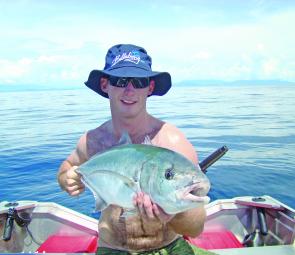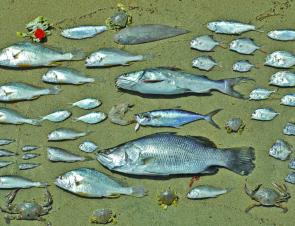By now we would have all seen the good, the bad and the ugly of the tropical wet season. With another month or so of expected decent rainfall it is a matter of fishing smarter and not harder, and making the most of those settled days. These conditions include reasonable water clarity with abating winds.
With the amount of rainfall in recent times a lot of bait has been spread far and wide particularly along our spectacular coastline. At the start of the barra season a lot of these prized fish were sourced from our beaches and headlands where the bait was accumulating. Such bait have included garfish, mullet, whiting, prawns and the microscopic jelly prawns. Anglers have had success fly fishing, live baiting and casting small lures and poppers where there is evidence of bait on the surface. The days leading up to the new and full moon have been best when the tide is on the turn correlating with dawn and dusk periods. Northerly winds have made this fishing difficult at times but best results have occurred when there is a light easterly or south easterly breeze.
Hot spots along our coastline for barra have been southern Four Mile Beach, Cooya Beach flats and Wonga Beach. Mixed in the catch have been tarpon, giant herring, queenfish, trevally, dart, blue salmon, black tip sharks, shovel nose and smaller silver jewfish and permit. Basically anything is a possibility along our golden sands at the moment.
There is one strong plead from the local fishing community at the moment and that is if you are bait netting for prawns along our beaches don't empty your by-catch along the foreshore. Collect your prawns from the net in the shallows and allow the other smaller fish to swim away. All it takes is a bit more time and care to avoid the waste of juvenile fish left to rot on the sand. There has been evidence of negligent netting by recreational anglers in recent times and it simply shows a lack of respect for our local marine life.
Another area that is fishing really well at the moment is the flats of our river systems including the Daintree River. Even though conditions haven't been ideal all the time these areas are producing thumping grunter up to 70cm consistently. Live baiting has worked well but it is the use of slabs of bait fillet that have seen anglers coming up trumps. Whether the water clarity is clear or inundated with fresh or dirty water a lightly weighted fillet of sardine or mullet on a running sinker has been snaring the bigger variety.
In the rivers, the deeper holes in the channels with some form of structure are offering good-sized fingermark using live sardines and the mangrove edges are alive with quality jack ready to attack lures put in front of their nose. Actually the mangrove fishing has been excellent and it is good to see there is a good supply of quality fish in our local systems. Even better is the proposal to put a bag limit on these fish to ensure they are never over-exploited. For your jack fishing concentrate on the outgoing tide fishing the upside of any fallen mangrove clump or tree. Deeper diving lures carefully bumped through the forest will certainly attract attention.
Offshore when the weather permits, the days have been very warm. Reef catches have been sporadic but as was the case last month you'll likely come across quality rather quantity. The trend has been to pluck one or two nice fish from each spot and then it is a case of moving on. Fishing in 25m plus of water is necessary at this time of year and the better catches posted amongst the trevally hordes have included coral trout to 10kg and large mouth nannygai to 14kg.
Some reefs are holding a good supply of bait on the pressure points where a variety of fish have been working the surface including northern bluefin tuna, big eye and bludger trevally with the odd mackerel as well. Casting 15-25g metal sliced lures into the feeding school and cranking the handle has produced alternative fun when the reef fishing has been quiet. This style of fishing is exhilarating as it is very visual as fish crash through the surface in close range and you see the fish clamber all over your lure as you retrieve it. When heading offshore I'll always have a light spinning rig ready to go just in case something crops up. Sometimes the best angling opportunities are spontaneous and not necessarily planned.
Persist through the remaining wet season and take your chances when the weather presents.
Reads: 6042
Stuey Sowden nailed this bludger trevally whil casting metal slices at bluefin tuna schools.

Matt Shaw lured this classic barra caught at Bathurst Heads along the beach (pre-closed barra season).

Left on the beach to rot after bait netters worked the shores of Wonga Beach - notice the juvenile barra!




